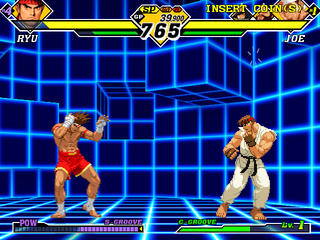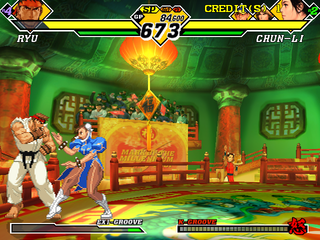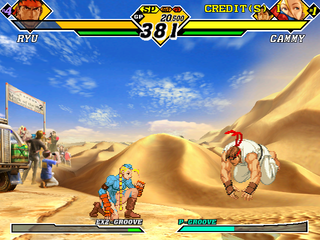Capcom vs. SNK 2: Mark of the Millennium 2001 (Arcade)
| Capcom vs. SNK 2: Mark of the Millennium 2001 (Arcade) |
|---|
|
Also known as: Capcom vs. SNK 2: Millionaire Fighting 2001 (JP)
|
CHECK YOUR TRAINING WHEELS AT THE DOOR.
To do:
|
Contents
Leftovers from Capcom vs. SNK
It may not seem apparent from the start, since the first game doesn't use any real 3D in its backgrounds, Capcom vs. SNK 2 was built on its predecessor's engine. With this in mind, we can see leftovers from the first game in its sequel, like the fourth character slot.
You can have four characters on a team, but the game glitches out a bit trying to represent them in-game, since this was never meant to be done. You can set any number from the character list in memory address 2C241043 to have a fourth character.
Console-Exclusive Features
The arcade version of the game contains a few incomplete and disabled features that would later be made available in the home console versions of the game.
Unused Characters
As this video proves, the two console exclusive characters, Evil Ryu and Orochi Iori, are fully present in the arcade version, but there is no way to select them without hacking. It is possible that they were locked intentionally, though the reason why is unknown.
Training Stage
By setting memory address 2C225148 to 10, you can access the Training stage that is primarily used in the home console version. While it has no music at all, it acts like a normal stage with no glitches.
EX Grooves
By setting memory address 2C241050 to 6 or 7, you can access EX1 or EX2 groove (the memory address is for player 1 only). It is currently unknown if you can set any of the EX grooves to act anyway like they do in the console versions. Since they aren't useable in the arcade version, they are most likely just placeholders.
These current default EX grooves do not do much of anything but be able to use supers.
Regional Differences
| To do: Add photo/video examples for each point. |
Subtitle Change
The game's subtitle is different depending on the region. The Japanese version is subtitled Millionaire Fighting 2001, but elsewhere this was changed to Mark of the Millennium 2001. This change affects the title screen logo and announcer voice clip (though he still says "This is the Millionaire Fighting 2001" on the character select screen in all versions), the background of the groove select screen, and the text above the round timer.
Character Name Changes
As is the standard since Street Fighter II, a few characters' names are changed from the Japanese version to international releases:
- M. Bison (Boxer), Balrog (Claw), and Vega (Dictator) are respectively renamed Balrog, Vega, and Bison.
- Gouki is renamed to Akuma. This also applies to his secret boss form, Shin Gouki/Shin Akuma.
Additionally, Rugal's secret boss form is called God Rugal in Japan and Ultimate Rugal elsewhere.
System Name Changes
- A-Groove allows the player to activate a special mode that lets their character cancel any attack into any other attack for a limited time, at the cost of all remaining super meter. As in the Street Fighter Alpha series, this state is known as "Original Combo" in Japan and "Custom Combo" elsewhere.
- P-Groove's primary technique, originating in Street Fighter III, allows the player to negate an opponent's attack by tapping the joystick forward (or down for low attacks) a few frames before impact. This technique is known as "Blocking" in Japan (not to be confused with guarding—casually referred to as "blocking" in English—which is done by holding the stick away from the opponent), and "Parrying" elsewhere.
- The "Finest K.O." in the Japanese version is renamed "Dramatic K.O." in other versions, which also removes the announcer's unique line associated with it.
Character Victory Quotes
| To do: Fully translate all unique Japanese victory dialogue |
The Japanese version has unique win quotes in arcade mode for characters talking to their teammates (if on a team) or their defeated opponent (if solo). Each permutation of characters has its own dialogue. International versions omit this extensive dialogue, instead giving characters generic win quotes. A partial translation of the Japanese quotes can be found here.
The SNK/Capcom vs. series
| |
|---|---|
| Card Fighters | |
| Neo Geo Pocket (Color) | SNK vs. Capcom: Card Fighter's Clash • SNK vs. Capcom: Card Fighters 2 Expand Edition |
| Fighting games | |
| Neo Geo Pocket (Color) | SNK vs. Capcom: The Match of the Millennium |
| Arcade | Capcom vs. SNK: Millennium Fight 2000 • Capcom vs. SNK 2: Mark of the Millennium 2001 |
| PlayStation | Capcom vs. SNK Pro |
| PlayStation 2 | Capcom vs. SNK 2: Mark of the Millennium 2001 |
| Neo Geo | SvC Chaos: SNK vs. Capcom |
- Pages missing developer references
- Games developed by Capcom Production Studio 1
- Pages missing publisher references
- Games published by Capcom
- Arcade games
- Pages missing date references
- Games with unused areas
- Games with unused characters
- Games with unused game types
- Games with unused graphics
- Games with unused sounds
- Games with regional differences
- To do
- SNK/Capcom vs. series
Cleanup > Pages missing date references
Cleanup > Pages missing developer references
Cleanup > Pages missing publisher references
Cleanup > To do
Games > Games by content > Games with regional differences
Games > Games by content > Games with unused areas
Games > Games by content > Games with unused characters
Games > Games by content > Games with unused game types
Games > Games by content > Games with unused graphics
Games > Games by content > Games with unused sounds
Games > Games by developer > Games developed by Capcom > Games developed by Capcom Production Studio 1
Games > Games by platform > Arcade games
Games > Games by publisher > Games published by Capcom
Games > Games by series > SNK/Capcom vs. series




